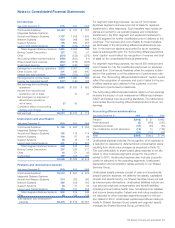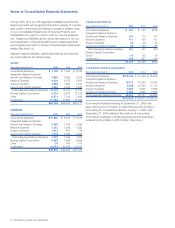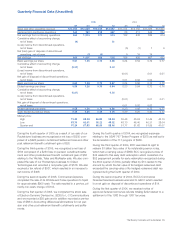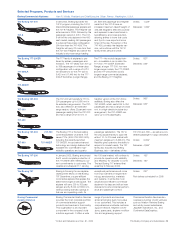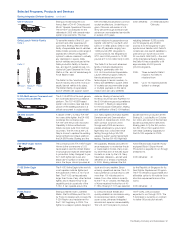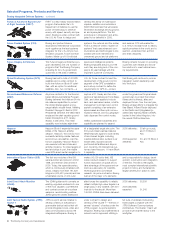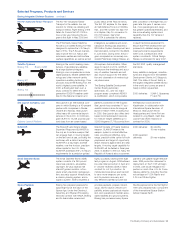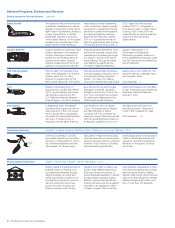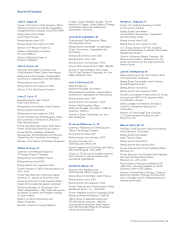Boeing 2005 Annual Report Download - page 94
Download and view the complete annual report
Please find page 94 of the 2005 Boeing annual report below. You can navigate through the pages in the report by either clicking on the pages listed below, or by using the keyword search tool below to find specific information within the annual report.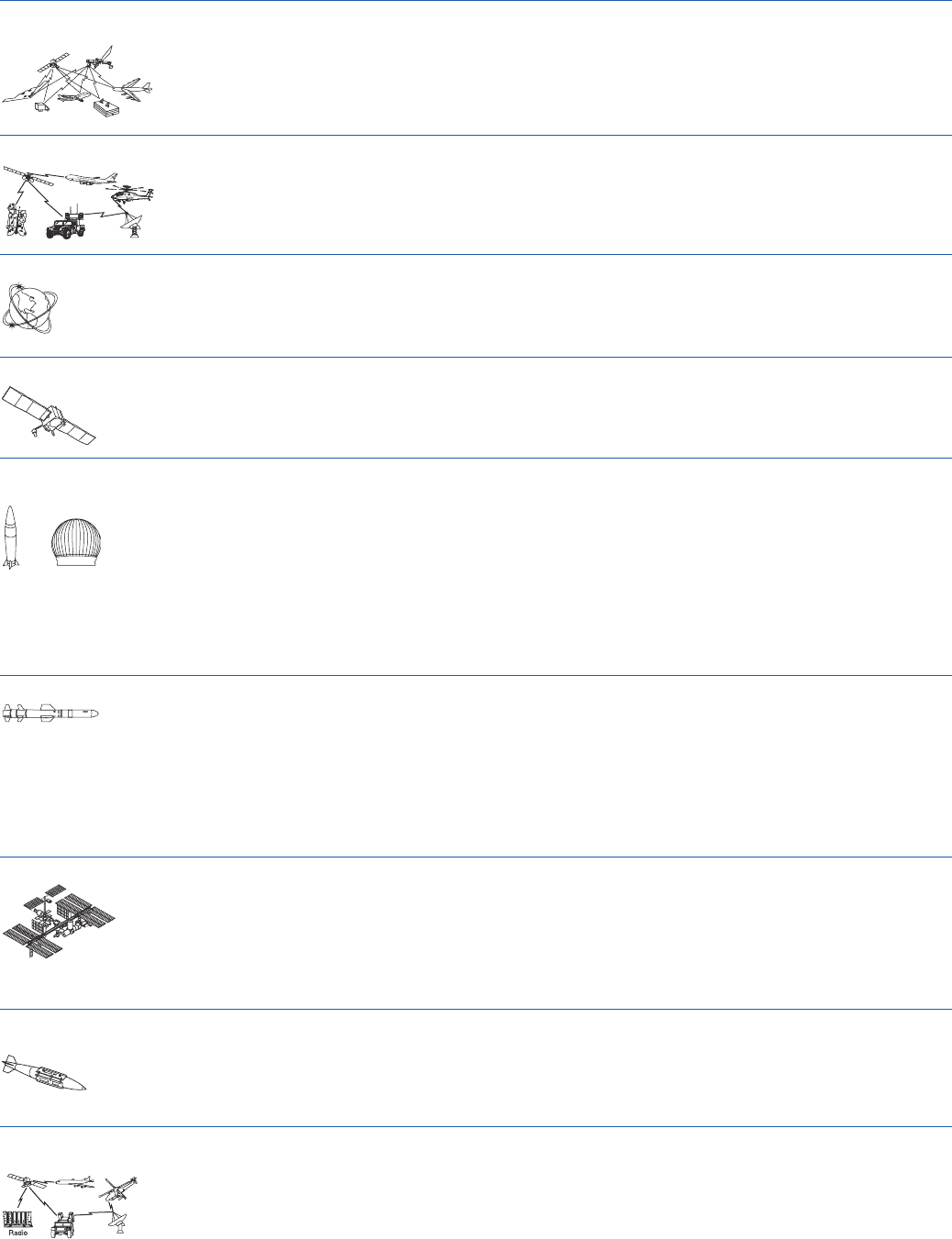
Joint Tactical Radio System (JTRS)
Cluster 1
JTRS is a joint service initiative to
develop a family of software-pro-
grammable tactical radios that will
provide integrated voice, video and
data communications across the
integrated battlespace. Boeing is
under contract to design and
develop JTRS Cluster 1— the first of
several “clusters” of radios under the
JTRS program. As prime systems
integrator, Boeing has implemented a
network-centric approach utilizing a
full suite of wideband networking
technologies compliant with the
JTRS Software Communications
Architecture. The Cluster 1 team will
provide multi-channel radios to the
warfighter.
92 The Boeing Company and Subsidiaries
Future Combat System (FCS) Boeing and partner Science
Applications International Corporation
work together as the lead systems
integrator for the U.S. Army’s mod-
ernization program, Future Combat
System. Made up of 18 individual
systems, the network and the soldier,
FCS is a network-centric “system of
systems” that uses advanced com-
munications and technologies to link
soldiers with both manned and
unmanned ground and air platforms
and sensors. FCS will enable the
U.S. Army’s modular force to deploy
rapidly anywhere in the world and to
see first, understand first, act first
and finish decisively.
Family of Advanced Beyond-Line-
of-Sight Terminals (FAB-T)
FAB-T is a key military transformation
program that enables the U.S.
Department of Defense to use the
power of technology to strike an
enemy with speed, security and pre-
cision. Boeing is under contract with
the U.S. Air Force to design and
develop this family of multimission
capable, satellite communications
(SATCOM) terminals that will enable
information exchange among ground,
air and space platforms. The first
prototype is in integration and antici-
pated to be delivered in 2006.
Future Imagery Architecture The Future Imagery Architecture pro-
gram represents one of a number of
programs that The Boeing Company
is leading for its U.S. government
customers in the area of defense,
space and intelligence systems.
Boeing employees are proud of the
work they are doing and of the com-
pany’s 40-year heritage with this
important customer community.
Boeing remains focused on providing
customers with reliable and innova-
tive solutions to meet national secu-
rity requirements.
Global Positioning System (GPS) Boeing has built a total of 40 GPS
satellites and is under contract to
build nine follow-on Block IIF satel-
lites, with an option for additional
satellites. Also, two contracts — a
U.S. Air Force contract to lead the
development of the ground control
segment of the GPS constellation
and a study contract to define the
requirements for GPS III — ensure
Ground-based Midcourse Defense
(GMD)
As prime contractor for the Ground-
based Midcourse Defense Program,
Boeing delivered the initial set of mis-
sile defense capabilities to protect
the United States against a long-
range ballistic missile threat. Meeting
President George W. Bush’s 2002
Presidential Directive, the GMD team
emplaced five alert-capable ground-
based interceptors at Ft. Greely,
Alaska, in late 2004. This initial
capability now includes eight inter-
ceptors at Ft. Greely and two inter-
ceptors at Vandenberg Air Force Base,
Calif.; and other assets to include
land- and sea-based radars, a battle
management command and control
system consisting of an extensive
space-based and fiber-optic commu-
nications network, and two geograph-
ically dispersed fire-control nodes.
GMD’s operational robustness and
capability are planned to expand
under the government’s spiral devel-
opment plan to protect the United
States and its friends, allies and
deployed forces. Over the next year,
Boeing will lead efforts to integrate the
Sea-Based X-Band Radar deployed
in the Pacific and Fylingdales Up-
dated Early Warning Radar (UEWR),
located in the United Kingdom, into
the overall GMD architecture.
Harpoon Harpoon Block II expands the capa-
bilities of the Harpoon antiship
weapon. Harpoon, the world’s most
successful antiship missile, features
autonomous, all-weather, over-the-
horizon capability. Harpoon Block II
can execute both land-strike and
antiship missions. To strike targets on
land and ships in port, the missile
uses GPS-aided inertial navigation to
hit a designated target aim point. The
500-pound blast warhead delivers
lethal firepower against a wide variety
of land-based targets, including
coastal defense sites, surface-to-air
missile sites, exposed aircraft,
port/industrial facilities and ships in
port. Currently, 26 international cus-
tomers have Harpoon; 11 have Block
II capability.
2005 deliveries: 50 all-up rounds,
and 131 Block II
Kits
2006 expected 50, and 19 Block II
deliveries: Kits
Selected Programs, Products and Services
International Space Station (ISS) The first two modules of the ISS
were launched and joined in orbit in
1998, and the first crew arrived in
2000. Today, the space laboratory,
which is continuously inhabited with
crews, weighs more than 181,629
kilograms (400,423 pounds) and has
a habitable volume of 425 cubic
meters (15,000 cubic feet). ISS
crews conduct research to support
human exploration of space and to
take advantage of the space environ-
ment as a laboratory for scientific,
technological and commercial
research. As prime contractor, Boeing
built all of the major U.S. elements
and is responsible for design, devel-
opment, construction and integration
of the ISS. The ISS is the largest,
most complex international scientific
project in history and humankind’s
largest adventure in space to date.
Joint Direct Attack Munition
(JDAM)
The JDAM guidance kit converts an
existing unguided warhead into one
of the most capable, cost-effective
and combat-proven air-to-surface
weapons, revolutionizing warfare.
JDAM gives the United States and
allied forces the capability to reliably
defeat multiple high-value targets in a
single pass, in any weather, with min-
imal risk to the aircraft. More than
145,000 JDAMs have been delivered.
2005 deliveries: 35,509
2006 deliveries
expected: 31,245
Boeing Integrated Defense Systems continued
that Boeing will continue to provide
navigation system leadership well
into the future.



